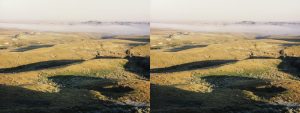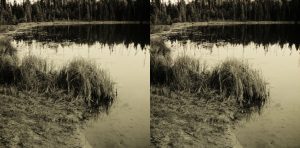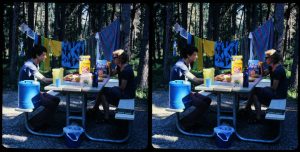Pompeii is an incredible place to visit. Not only do you feel like you have stepped back in time when you are there, but you are also essentially walking through a gravesite. It’s eeriness combined with the story of that fateful day in 79 AD, makes it all the more profound. One could spend hours walking it’s long narrow streets, peering into the empty shells of homes, and imagining the horror that would have flowed through the town that day. It really sends chills down your spine. This shot was one of my favorites that I took on this trip, however the only personal ‘beef’ that I have with this shot is that it’s a little underexposed. The medallions, I’m sure are ‘new’ and were placed there not long ago. However, I don’t know for sure, since there were no markers to say otherwise. There are many hidden gems in Pompeii, from tiny scribbles on the walls by children, hidden brothels, and splendid mosaics in hallways or doorways. Worth a visit if you are ever in the neighborhood. Shot with my Sputnik, on you guessed it, Fuji Provia 100f.
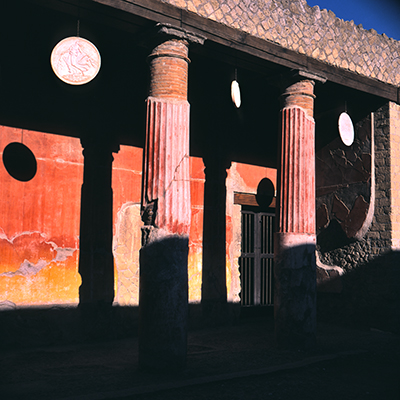
Tag Archives: Sputnik
The Tourists – Palatine Hill, Rome, Italy 2022
Just outside of the main Roman Forum and Colosseum is Palatine Hill. This is where alot of the senators and statesman lived, amongst some of the most prestigious and wealthy Roman citizens. The views of the surrounding area, and it’s natural beauty made it an ideal spot for such folks. Walking around it’s remnants of the past, I noticed a couple sitting not far from us, trying to shield themselves from the afternoon sun. I knelt down and captured their ‘break’ from the heat. Shot with my Sputnik spy camera, on (the now coveted) Fuji Provia 100f.
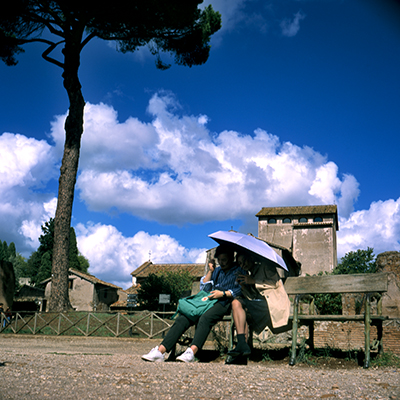
Elysse 609
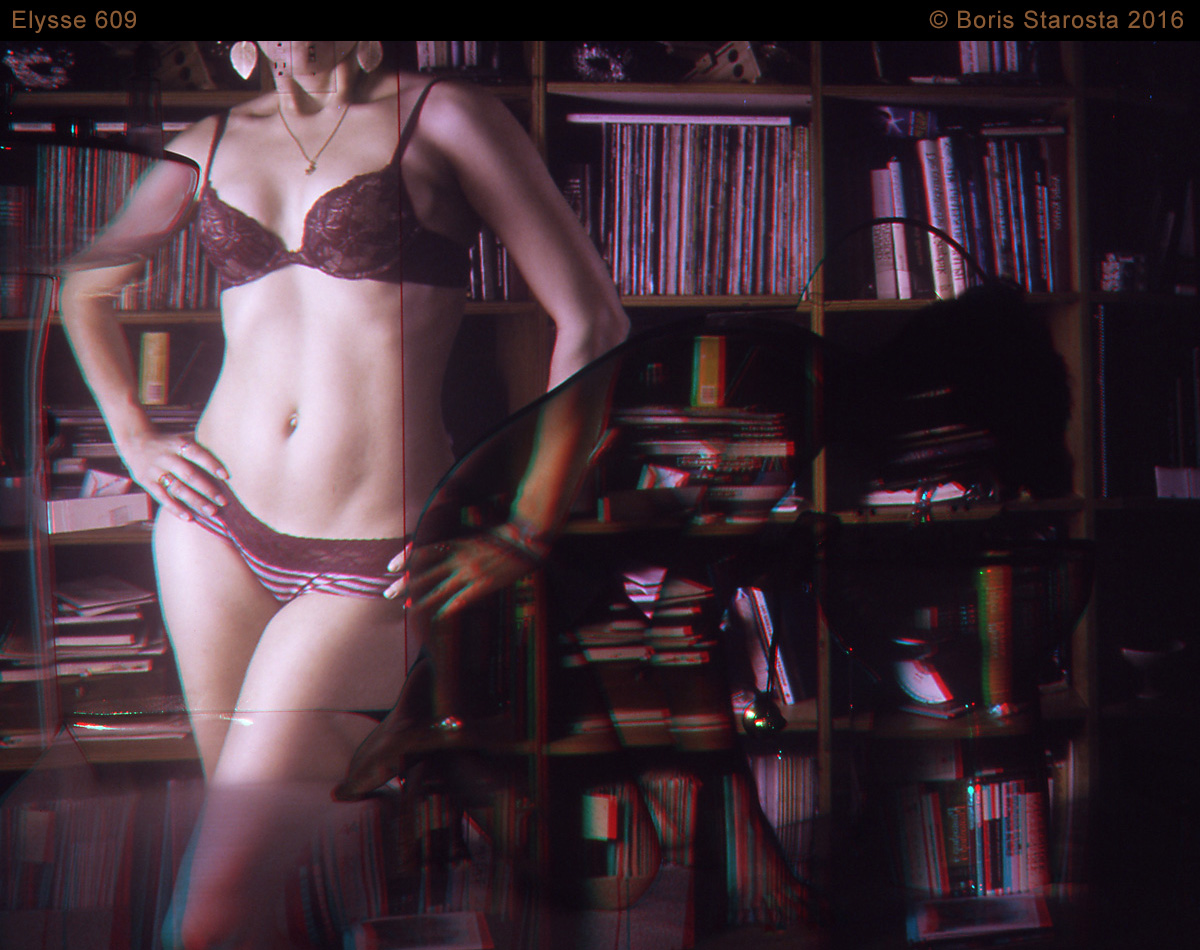 More recent work (in progress). Mixed lighting in studio, Fuji RXP 400, shot with Sputnik. Can you figure this one out?
More recent work (in progress). Mixed lighting in studio, Fuji RXP 400, shot with Sputnik. Can you figure this one out? Michele + Jet in Philly (Zagar A208)
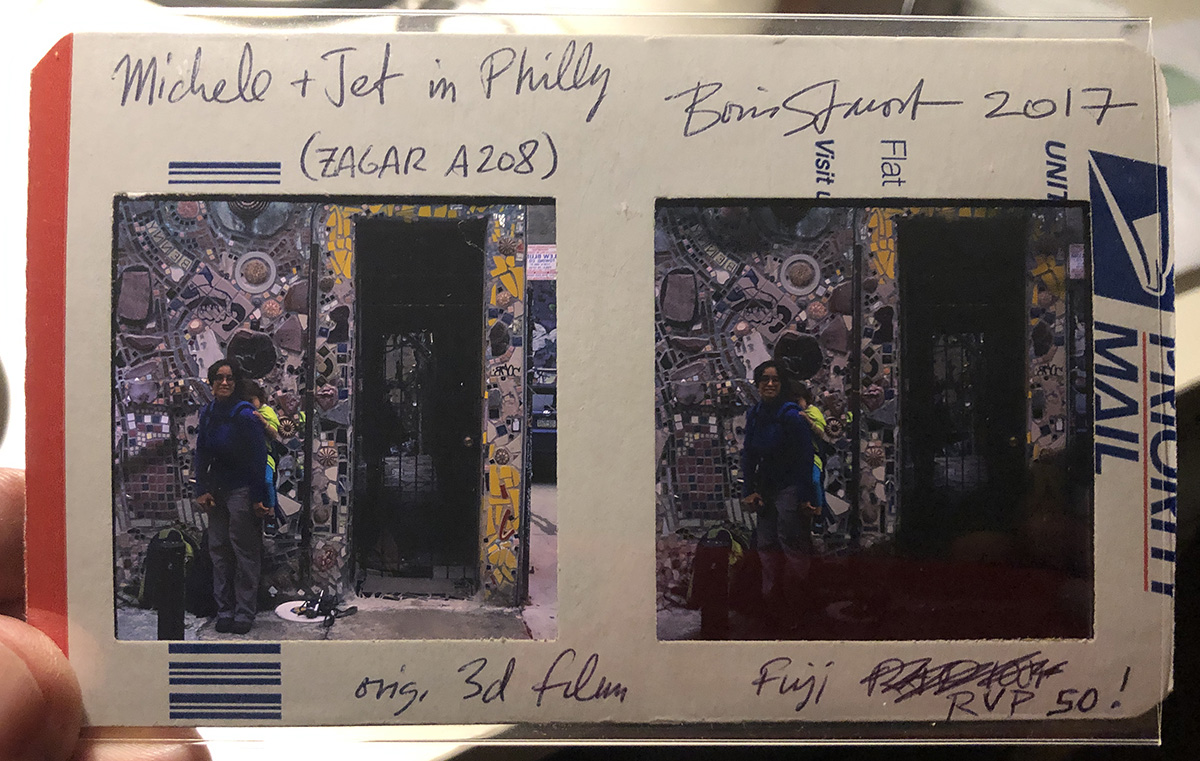
Sometime around 2017 we visited Philadelphia to take in a concert by Raffi, whose music Jet just loved to pieces. It was the furthest South that Raffi had ever travelled in his very long career of live performance for young audiences (Raffi is Canadian). Raffi is getting pretty old these days, so we jumped at the chance to go see him. Of course, a stereoscopic angle had to be included, so I undertook to find some of Isaiah Zagar’s thousands of murals. He has practically covered Philadephia with these distinctive works, which have a lot of stereoscopic interest, on account of the liberal use of bits of mirror. Learn more about Zagar’s opus here: https://www.phillymagicgardens.org/about-philadelphias-magic-gardens/about-isaiah-zagar/
Photography was done with a Sputnik shooting Velvia 50. But the weather was not as bright as I had hoped for. On the ground you can see my test exposure rig, a twin rig Sigma DP1 Merrill.
Scrutinizing Sharpness (Ian Andvaag A33)
Cathedral Basilica of Saints Peter & Paul
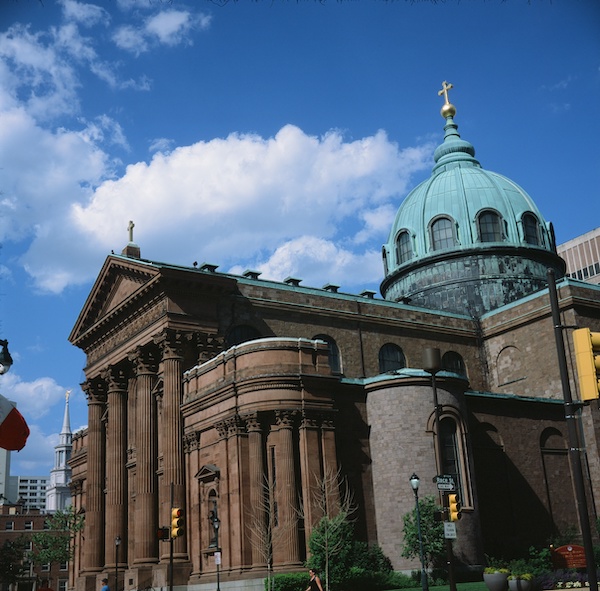
Last year was our 25th wedding anniversary. Those of you who were in the original MF3D Folio II might remember my honeymoon stereos from Ireland. For this trip we went to Trenton, NJ, where my brother-in-law (who married us) is currently a Bishop of the Episcopal church, so Liz could play the pipe organ there. And then it was on to Philadelphia.
This Roman Catholic cathedral was opposite our hotel in Philadelphia. We hadn’t really thought to try and get in see the organ here. We did see the Wanamaker Organ, but I didn’t think I could get a good exposure without a tripod.
My slides in this loop show a walk on a nice day in Philadelphia to City Hall.
This was taken with a handheld (string monopod) Sputnik on Fujifilm Provia 100F.
Swann Memorial Fountain
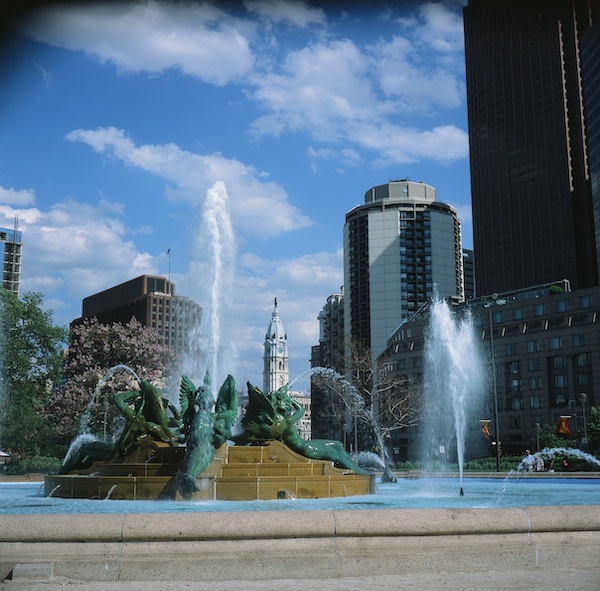
This is Swann Memorial Fountain in Philadelphia. Several of Philadelphia’s museums are located around this square.
This scan shows the least intrusive vignetting I had from my lens shades on this trip. Luckily the 6×4.5 mounts allow me to crop it out in this case.
This was taken with a handheld (string monopod) Sputnik on Fujifilm Provia 100F.
Love Park

This is Love Park in Philadelphila. The statue in the foreground is very similar to ones I’m more familiar with seeing back home in New York. The traditional Philadelphia Love statue can just barely be seen on the other side of the fountain. It faces the wrong direction to get City Hall in the background.
This was taken with a handheld (string monopod) Sputnik on Fujifilm Provia 100F.
City Hall
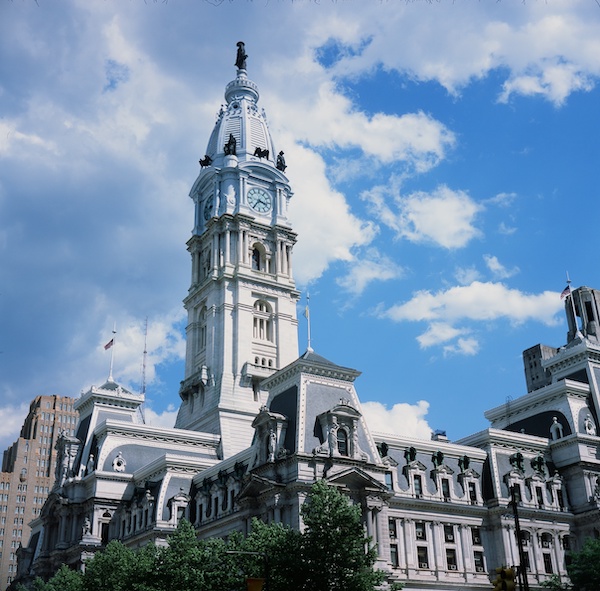
This is the Philadelphia, PA city Hall. Unfortunately, due to trouble with the lens shades I use, this is the only photo that was usable.
This was taken with a handheld (string monopod) Sputnik on Fujifilm Provia 100F.
Temple Mount, Jerusalem, Israel 2018
Temple Mount is a very important site for Muslims, Jews, and Christians. It is a beautiful courtyard in East Jerusalem and is defined to be one of the holiest sites in the world. The al-Asqa Mosque is a sight to see, and since it was a beautiful day when I was there, I went nuts trying to capture it’s beauty shooting from all angles. This shot was one of my favorites of what I captured. The walled arch in the picture is called the scales of judgement, believed to be the place where people would be judged before entering the gates of heaven. Note the sundial on the arch. Israel is filled with religious history and a must see for anyone interested in the subject. Shot with my Sputnik, on Fuji Provia 100f. 
Cormorant Fisherman, Guilin, Guangxi Province, China 2018
In a gorgeous area of China, on the Li River in Guilin, there is an old form of river fishing. The fishermen use cormorant birds to catch fish. The way it works, is that the fishermen would raise the birds from chicks and the birds would then trust the fishermen. Once old enough, the birds would start fishing by instinct by diving to get the river fish. The birds would dive into the river, and come up with the fish in their mouth, which would be snatched from them by the fishermen. The birds would eventually be rewarded, albeit with smaller fish. This practice of fishing is actually not really used much anymore, and has become more of a novelty for tourists, like myself. I wanted to get an iconic image of the fisherman while I was there, but unfortunately the opportunity did not present itself. However, an easy going fisherman let me do a snapshot of him while we were walking down the riverbank. Shot on my Sputnik, with Fuji Provia 100f.
Kathmandu Durbar Square, Kathmandu, Nepal 2016
Kathmandu Durbar Square is an incredible area of Kathmandu, filled with old temples originally built and rebuilt from around the third century. We arrived one year after a major earthquake damaged many buildings in this square. It still held up it’s integrity and prestige even after most of the damage. Sadly some of the temples were reduced to rubble and were only recognizable by placards set up by the tourist government. Due to the damage to Nepal and to it’s infrastructure, there seemed to be less tourists than we had anticipated while we were there, and allowed us to explore most areas in less crowded situations. This shot was taken in the early morning, while locals were out feeding the pigeons. Shot on my Sputnik, on Provia 100f film.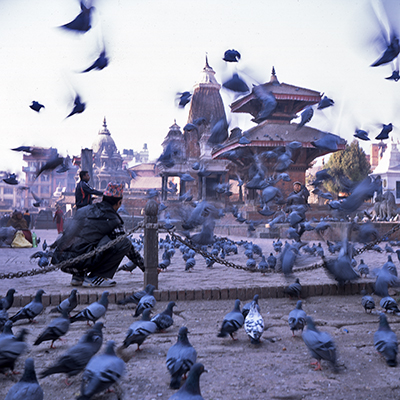
Cusco Cathedral, Cusco, Peru 2017
Cusco is a fascinating town in Peru located near Machu Picchu, and is often where travelers acclimate to the high altitudes before heading off to the famous ruins. There are many old buildings built by the conquistadors, often using stones originally cut out by the Incan, scattered throughout the town. One of the more ornate and beautiful buildings is the Cathedral Basilica of the Assumption of the Virgin, or Cusco Cathedral for short. While we were out walking one evening, I wanted to stop and get an interesting shot of the church lit up. While walking up the steps to the church, I noticed that there were two Quechuan women sitting on the steps. This was taken on my Sputnik, when it was still working properly, on Fuji Provia 100f.

The Built Environment – Architecture and Machines
Ages ago, I shot this view of the (then) new UVA Hospital with a Hasselblad, maybe two of them on a bar – in any case this is a cha-cha to obtain the necessary stereobase, which was probably around a foot, judging from the parallax in the image. I imagine the exposure was around 30 seconds. Extra credit for the astronomers in the group that can identify the stars in the sky:

UVA Hospital, Charlottesville, VA
My “day job” is technical illustration. My clients are engineers at the University of Virginia, mostly. One day I went to visit a lab, and discovered this gigantic machine. Impossibly complex in its construction, for all I knew it could have been a time machine. So I started calling it the “time machine,” whenever I mentioned to my engineer client, and that I’d like to come in some day to photograph it. The title of the image that I finally made says about the same thing. For real, this is a Directed Vapor Deposition machine. A big electron gun hits one material, vaporizes it, and the vapors are deposited onto another material. Believe it or not, it is not a custom made machine. You buy these things retail. Cost? about $1M:
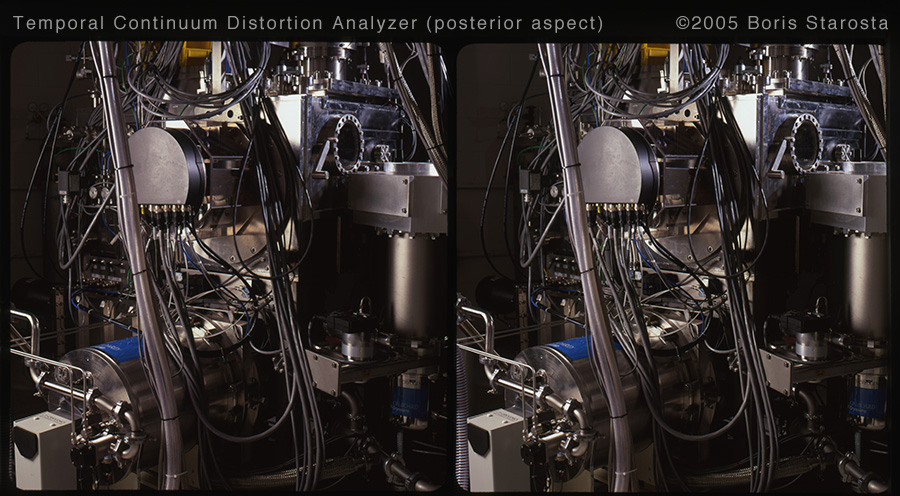
Temporal Continuum Distortion Analyzer (Posterior Aspect)
In or around 2012, I had the opportunity to photograph inside a retired coal-fired power plant not far from where I live. This plant, in Bremo Bluff, VA, was the first “automatic” coal fired power plant built in USA. “Automatic” meant in those days that most of the valves, flaps, conveyor belts, and other machinery was centrally controlled. Which means, there was a central control room, where through the use of electrical switches, one could remotely actuate any of the hundreds of valves in the plant – as these were electrically actuated. I’m sure there was a measure of fear or distrust in the system early on, as plant operators were instead used to shouting control commands at a team of plant workers, on whom one could surely better rely to get the job done than the new-fangled electric motors.
I worked on three separate days in the plant to make photographs, using with great pleasure John Thurston’s custom TL-120-55 for the wide angle views. I am forever indebted to John for his generous loan of the camera to me that year. In this view we have my old friend Chuck Holzner up there on another level (see the white hard-hat?) taking some of his own pictures. Along the left side of the view, rising up through the various levels, is one of the four burners in the plant. These are 100 foot tall furnaces (not counting the smokestack outside the building!), that included Ash removal apparatus at the very bottom, a furnace chamber 1/3 of the way up including hundreds of pipes for heat exchange (i.e. for boiling water, making steam), and at the top a variety of filters to capture particulates in the exhaust. I’ll guess this was a three seconds exposure:
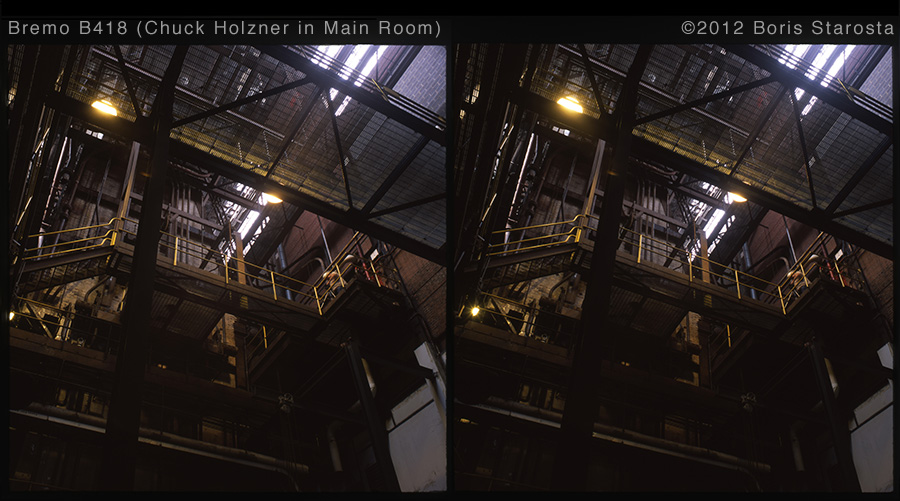
Bremo B 418 Main Room
Elsewhere in the plant, I captured this view of just a tiny fraction of the pipes and plumbing that, along with grated floors and vast spaces, characterized the place. Probably a thirty seconds exposure in this dark spot:
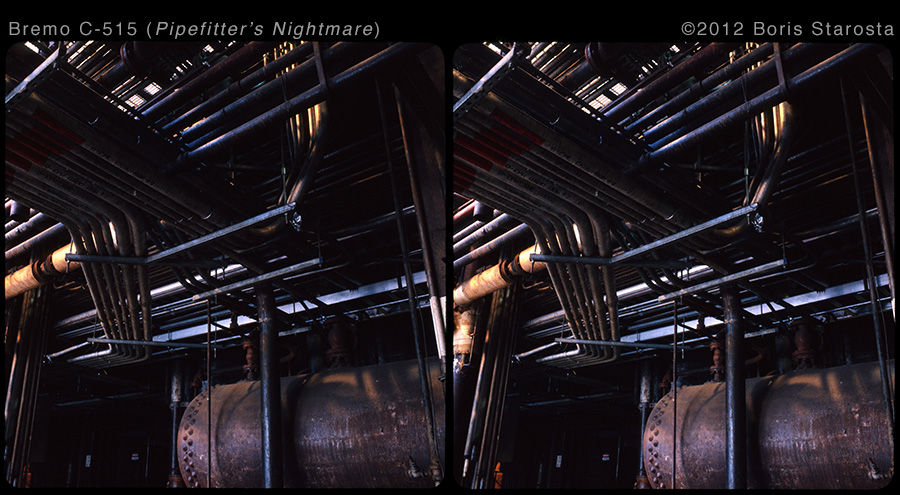
Bremo C 515 “Pipefitter’s Nightmare”
I’ll close with an image obtained in or around 2014 at the United States Botanical Garden in Washington, DC, where I fell in love with the “Jungle” greenhouse that is central to the place. In this three-stories tall greenhouse, one can commune with a variety of lush tropical plants, even in the deep of winter, and witness the slow motion battle between the built environment and the imprisoned flora. This picture was taken with a Sputnik, a good bit after sunset – I like the interplay of just a little natural light in the background, with artificial lights in the foreground. I imagine about a ten or twenty second exposure.

USBG-1302
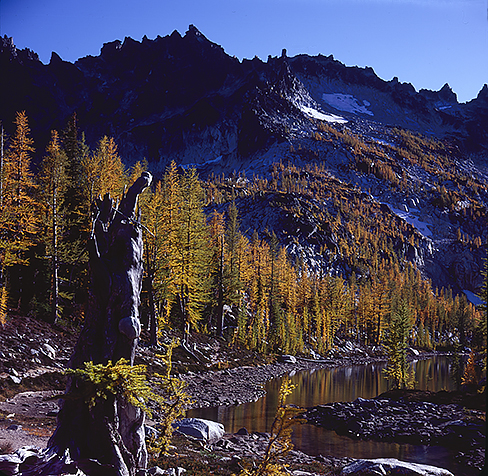
Alpine Lakes Wilderness, Fall 2006
